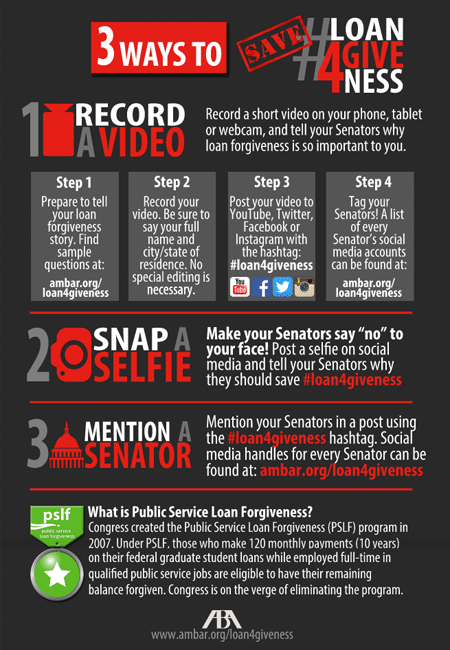ABA launches its first social media lobbying campaign to protect loan-forgiveness program

For the first time, the ABA is incorporating social media into a major advocacy initiative as it seeks to protect the federal Public Service Loan Forgiveness program from possible elimination by Congress.
“This is our first effort to use social media for advocacy,” says Thomas M. Susman, director of the ABA’s Governmental Affairs Office in Washington, D.C., which is conducting the campaign to preserve the PSLF Program. “Using social media for advocacy is a young person’s sport, but since our constituency on this issue is in large part students and young lawyers, they are an ideal audience for this approach.”
The PSLF Program was created by Congress to encourage individuals who have recently received degrees from undergraduate schools, graduate schools and professional schools, including law school, to enter and continue working full-time in public service jobs in government and the nonprofit sector. Under the program, individuals may qualify for forgiveness of the remaining balance due on their loans issued under the William D. Ford Federal Direct Loan Program after making 120 qualifying monthly payments on those loans while employed full-time by certain public service employers. In essence, someone working in the public sector may have the balance of their loan discharged after making monthly payments for 10 years while doing public service work, even if they have been paying reduced monthly amounts under income-driven repayment plans.
The ABA and other proponents of the PSLF Program maintain that it helps many law school graduates with significant debt burdens to nevertheless enter and remain in government or public interest jobs. While there are no definitive numbers on how many lawyers are working in government and nonprofit sector jobs that qualify for loan forgiveness under the PSLF Program, the most recent report on the employment status of 2014 graduates from ABA-accredited law schools, issued earlier this year by the Section of Legal Education and Admissions to the Bar, indicates that 16.6 percent of the graduates accounted for in the survey are working in either government or public interest jobs. But the U.S. Bureau of Labor Statistics estimates that the nation still has 500,000 fewer public service jobs than before the Great Recession of 2008, and some experts put the “public services job gap” at 1.5 million or more. Moreover, “The jobs that lawyers fulfill cannot be done by anybody else,” says Kenneth J. Goldsmith, legislative counsel and director of state legislation in the GAO.
Graduates of law school and other disciplines are not the only beneficiaries of the PSLF Program, says the ABA. “Public Service Loan Forgiveness is not merely a program for making graduate and professional education affordable for all Americans,” states a report submitted to the association’s policy-making House of Delegates in August 2014 by the Standing Committee on Legal Aid and Indigent Defendants in support of a recommendation urging Congress and the Obama administration to continue student loan forgiveness programs and opposing an administration proposal to limit the amount of loans that would be forgiven after borrowers made monthly payments for 10 years. The program “also provides substantial benefits for the public, through the services provided by talented individuals who are willing and able to accept moderate salaries in order to help people in need, particularly the poor.” The recommendation adopted by the House last year is the immediate basis for the ABA’s current efforts to preserve the PSLF Program.
In terms of timing, the ABA’s effort is essentially preemptive in nature. So far, no bills have been filed in Congress seeking to repeal the PSLF Program, says Goldsmith. A House of Representatives report included in a budget resolution that was never passed recommends repeal of the program. A proposal to repeal the program also could be included in a Senate bill to reauthorize the Higher Education Act, which includes the PSLF Program and other educational loan forgiveness programs.
But in developing a strategy to preserve the PSLF Program, Susman and other members of the GAO working on the issue determined that the usual methods of trying to get the attention of federal legislators wouldn’t be enough. They decided that the loan forgiveness issue would be a good fit for a social media campaign, especially since the issue is crucial to so many recent law school graduates.
“This isn’t replacing our retail lobbying, but it is supplementing it,” says Susman. “It’s an effort to step up a notch our ability to cut through the noise level on Capitol Hill.”
These days, says Susman, even email is losing much of its effectiveness. “Members of Congress get thousands of emails, they’re drowning in them,” he says. “But every congressional office monitors Twitter accounts for mentions of their name. If enough come in, it will be brought to their attention.”
The key is to use social media to tell stories that show how individuals are affected by the PSLF Program, says Jared D. Hess, legislative coordinator and director for grassroots operation in the GAO, who is coordinating the social media campaign. A relatively few social media comments can be just as effective as hundreds of emails or more, he says, because they tie comments directly to an actual person and because social media posts are public and can be viewed by others outside of congressional offices. Some lawyers participating in the PSLF Program already have posted messages and even some videos. “Stories are the most effective grassroots tool,” says Hess, telling how losing the program would affect them and the people they serve.”
The GAO’s page on the ABA website provides step-by-step guidance on how to develop messages, including videos and selfies, and send them to members of Congress. The page even includes a list of social media handles for members of the Senate, where the key battles over the future of the PSLF Program are likely to be fought. Hess produced a 30-second message about the need to preserve the loan forgiveness program and an identifying logo stating the theme of the initiative: “What will you do without loan forgiveness?”
The initial response has been positive, says Hess, with hundreds of posts so far on Twitter. And he’s hoping for more to come. “If people are willing to work for 10 years to participate in the program,” he says, I would think they’d be willing to devote 60 seconds to help save the program.”
Updated at 12:50 p.m. to add images and video.




